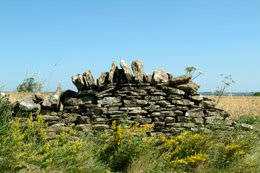 The Cotswolds are made of limestone, to be specific oolitic limiestone. To geologists it’s calcium carbonate pressed together tightly like fish roe. The ancient greek words that make up ‘oolite’ are for ‘egg’ and ‘stone’. So much for geology, for most visitors the real appeal of limestone is in the colour of a hotel in Cotswolds stone or a row of cottages, as well as the curve of the landscape.
The Cotswolds are made of limestone, to be specific oolitic limiestone. To geologists it’s calcium carbonate pressed together tightly like fish roe. The ancient greek words that make up ‘oolite’ are for ‘egg’ and ‘stone’. So much for geology, for most visitors the real appeal of limestone is in the colour of a hotel in Cotswolds stone or a row of cottages, as well as the curve of the landscape.You’ll see quarries all over the Cotswolds and it’s a still a requirement that buildings use local limestone for repairs and additions. The local limestone is usually thought of as yellow or gold but, when newly quarried, it varies from an orange-hued blond to a pale cream.
Your hotel in the Cotswolds is likley to evoke the gentle colours and gentle landscapes of the area, They are, after all, linked. Limestone is pretty soft and the gentle contours of the wolds have been formed by the action of the elements. No mountains, harsh contours or angularities here. The stone also dictates the landscape in other ways, beech woods are part of the landscape, rare and beautiful lime-loving wild flowers and grasses. In the slopes that are too steep to plough and by the side of the road more common flowers grow.
For centuries the Cotswolds was dominated by open sheep-friendly terrain. To some extent these have been replaced by arable fields and, in the right season, fields sway with green, bronze or the acid yellow of rapeseed. Barley is king, it thrives on drained, shallow soil. A few years ago it occurred to someone that no-one was distilling some of this barley and The Cotswolds Distillery was created in pursuit of excellent whisky. Perhaps a something try at the end of a long day back at your hotel in the Cotswolds.
Hotel Building in Cotswolds Stone
 Cotswold stone, as well as shaping the natural landscape so directly has also dictated the character and form of local buildings. Some oolites form a fine-grained stone which is easy to cut - in fact it can literally be sawn into blocks. This is when it is newly quarried, later it hardens on exposure to the air.
Cotswold stone, as well as shaping the natural landscape so directly has also dictated the character and form of local buildings. Some oolites form a fine-grained stone which is easy to cut - in fact it can literally be sawn into blocks. This is when it is newly quarried, later it hardens on exposure to the air.
This material forms the basic building material for your hotel and Cotswolds houses and other structures. Even the rooftiles are made of a specific type of surface Cotswold stone, which splits when left over winter into a usable thickness. Flooring, too, is made of local stone. The saying is that you can do anything with Cotswold stone except eat it.
Hotel buildings in the Cotswolds are often former manor houses and, indeed,
The Cotswolds area is famous for its cute cottages and manor houses, but also for stone walls. This is a reminder that stone was once easier to come by here than wood.Visit ancient sites such as Belas Knapp, a long barrow near Winchcombe and you’ll see ancient slated walls, supplemented by modern ones - the skill hasn’t changed much in 4000 years. Stone walling needs to be made of the right stone quarried at the right time of year - if not it will crumble due to frost damage after a few winters, something that sometimes people discover when they pay too little for new drystone walls. Hotel, Cotswolds, landscape - all together as one perfect rural escape.